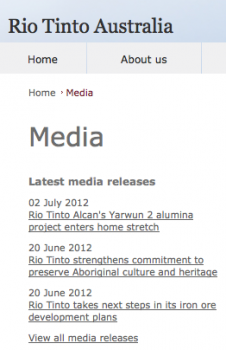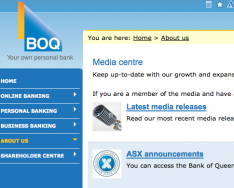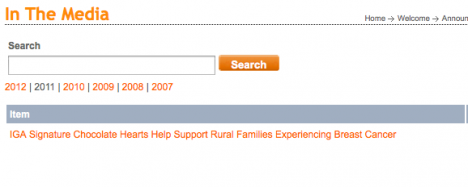Study reveals best and worst corporate newsrooms of Australia’s listed companies; Rio Tinto is top, Bank of Queensland is bottom
 A report has revealed the best and worst corporate newsrooms of companies listed on the ASX by how effectively they deliver news to journalists through their websites.
A report has revealed the best and worst corporate newsrooms of companies listed on the ASX by how effectively they deliver news to journalists through their websites.
Controversial mining giant Rio Tinto has by far Australia’s best online newsroom, while the Bank of Queensland has the worst, according to the study by Comnicate Media, a corporate newsroom provider.
The report measured ASX100 corporate newsrooms in terms of content quality, ease of distribution and user experience. Each newsroom was scored out of 100 – the average score was 52.
The study also benchmarked Australian firms against their international peers.
Resource companies such as mining and energy and banks emerged as having Australia’s best corporate newsrooms.
Australia’s best ten corporate newsrooms
- 91/100 Rio Tinto
- 82/100 AMP
- 82/100 Telstra
- 76/100 ANZ Banking Group
- 75/100 Woodside Petroleum
- 74/100 Origin Energy
- 73/100 Treasury Wines
- 72/100 Commonwealth Bank
- 70/100 Qantas
- 70/100 Iluka Resources
Retail and healthcare firms were found to be playing catch up, according to the study.
Australia’s worst ten corporate newsrooms
- 38/100 David Jones
- 37/100 Computershare
- 36/100 Beach Energy
- 36/100 Bluescope Steel
- 35/100 QBE Insurance Group
- 34/100 CSR Limited
- 34/100 Primary Health Care
- 34/100 Sonic Healthcare
- 32/100 Seven West Media
- 30/100 Bank of Queensland
 “The reports shows that the big mining companies like Rio Tinto understand the power of media, and the power of lobbying,” said Anthony Bodin, CEO of Comnicate Media. “They leave no stone unturned in terms of having an effective online media room, protecting their public image and being on message.”
“The reports shows that the big mining companies like Rio Tinto understand the power of media, and the power of lobbying,” said Anthony Bodin, CEO of Comnicate Media. “They leave no stone unturned in terms of having an effective online media room, protecting their public image and being on message.”
“It’s fair to say that retail companies are languishing in terms of their corporate newsrooms, reflecting the general consensus that Australia’s retail sector is behind its counterparts internationally,” Bodin said. “It seems that people’s perceptions of these companies carries through to the reality in terms of how well they are delivering information to journalists.”
Bodin pointed out that Seven West is an interesting case, as the company might view Yahoo!7 as being its media centre. “However, the drivers for a journalist are different to the stakeholders of Yahoo!7,” he said.
Not all ASX listed companies were included in the study, and firms such as Fairfax Media were excluded given that they are ‘acknowledged leaders’ in creating and distributing news and content, according to the study.
The report ranked corporate newsrooms by sector, including a best practice overseas benchmark listed at the top of each table.
Resources (mining and energy)
- 94/100 Anglo American Mining (global benchmark)
- 91/100 Rio Tinto
- 75/100 Woodside Petroleum
- 70/100 Iluka Resources
- 65/100 BHP Billiton
- 64/100 Alumina
Banks
- 98/100 Barclays Bank (global benchmark)
- 76/100 ANZ Banking Group
- 72/100 Commonwealth Bank
- 57/100 Suncorp
- 56/100 NAB
- 53/100 Westpac Banking Corporation
- 47/100 Bendigo Bank
- 30/100 Bank of Queensland
Retail
- 75/100 Wal-Mart (global benchmark)
- 68/100 Myer
- 52/100 Wesfarmers
- 45/100 Woolworths
- 42/100 Harvey Norman
- 39/100 JB Hi Fi
- 38/100 David Jones
Pharmaceuticals & health
- 97/100 Pfizer (global benchmark)
- 54/100 Ramsay Healthcare
- 50/100 CSL
- 34/100 Primary Healthcare
- 34/100 Sonic Healthcare
The report concluded that the ability or otherwise of an ASX company to effectively use new media, social media and web-enabled communication can mean the difference between a good news story or no news at all.
It read: “It is not unreasonable to conclude that a poor score by any company may be symptomatic of an underlying management weakness in the understanding of web 2.0 technology. Poor score results may therefore be a ‘red flag’.”
“In addition to the application of technology, newsrooms must be regularly populated with interesting news content. We found a number of companies with newsrooms that contained little actual news, potentially suggesting deeper problems within the company. As an example, when we conducted our research we noted that Metcash had posted just one general news item in 2012 and one general news item in 2011. Clearly, if a company has a news portal, then it must provide regular news streams.”



So glad to see Comnicate getting some traction – we’ve been on board since 2011 and its been insanely good in helping us manage Asia-Pac and North American communications. We publish our own and industry content to multiple platforms (RSS, web, blogs, events) all from the same interface and the marketing team is in full control – NO IT!
Any report that rates Pfizer as a global benchmark with 97 out of 100 has obviously been compiled under the influence of mood altering drugs.
what an appalling little PR survey
Comnicate can kiss goodbye any chance of the “offenders” using their services
Does anyone else find it more than ironic that the ‘global benchmarks’ all have been in the news recently for negative reasons and generally have dubious corporate reputations – Barclays, Wal-Mart, Anglo American and Pfizer??
And the little bit of astroturfing from Mr Trevena above almost made me vomit “so glad to see Comnicate getting some traction” [from having its press release published on Mumbrella – whoopee!!!!]
Any journalist worth their salt doesn’t go to a corporate newsroom for their news and any comms director worth their salt doesn’t rely on these to get their news out there – or the antiquated press release, either
in a painfully transparent attempt to link the ‘results’ with something meaningful, Mr Bodin has dropped some clangers – “The reports shows that the big mining companies like Rio Tinto understand the power of media, and the power of lobbying”…errr really, where does it prove the bit about the power of lobbying again?
and the arbitrary exclusion of Fairfax because it’s a news provider itself? WTF? the website either ticks the boxes or it doesn’t. Clearly it doesn’t, but Mr Bodin knows he would sound stupid saying Fairfax doesn’t understand the power of media.
i could go on but can’t stop laughing. This is the dumbest bit of small biz promotion i’ve ever seen on Mumbrella, bar none (and no, i have nothing to do with any of the companies mentioned therein)
Gave me a few reference points to orientate myself within. Comparing David Jones approach to Walmart was interesting for me. Saved me the time of starting from scratch. Cheers
I gladly back my judgement from what I’ve see it do for us – admittedly we’re not Walmart-sized yet Archibald.
Anyway, anyone can judge for themselves if they click the link to the left!
Curious to know what you concluded from your Walmart v David Jones comparison, Mr Span. Would you mind sharing please?
PDFs versus HTML for one. Can’t stand old school PDF approach. Lazy.
Walmarts images, videos etc. they have put effort into it. Can you see the difference between the Walmart approach and David Jones Archi? Seems obvious to me that DJs are fulfilling their legal obligations whereas Walmart is looking to engage.
Thanks to everyone who took the time to offer comments. Please note that if you need a copy of the 10 page Report Report it can be downloaded from the Comnicate website.